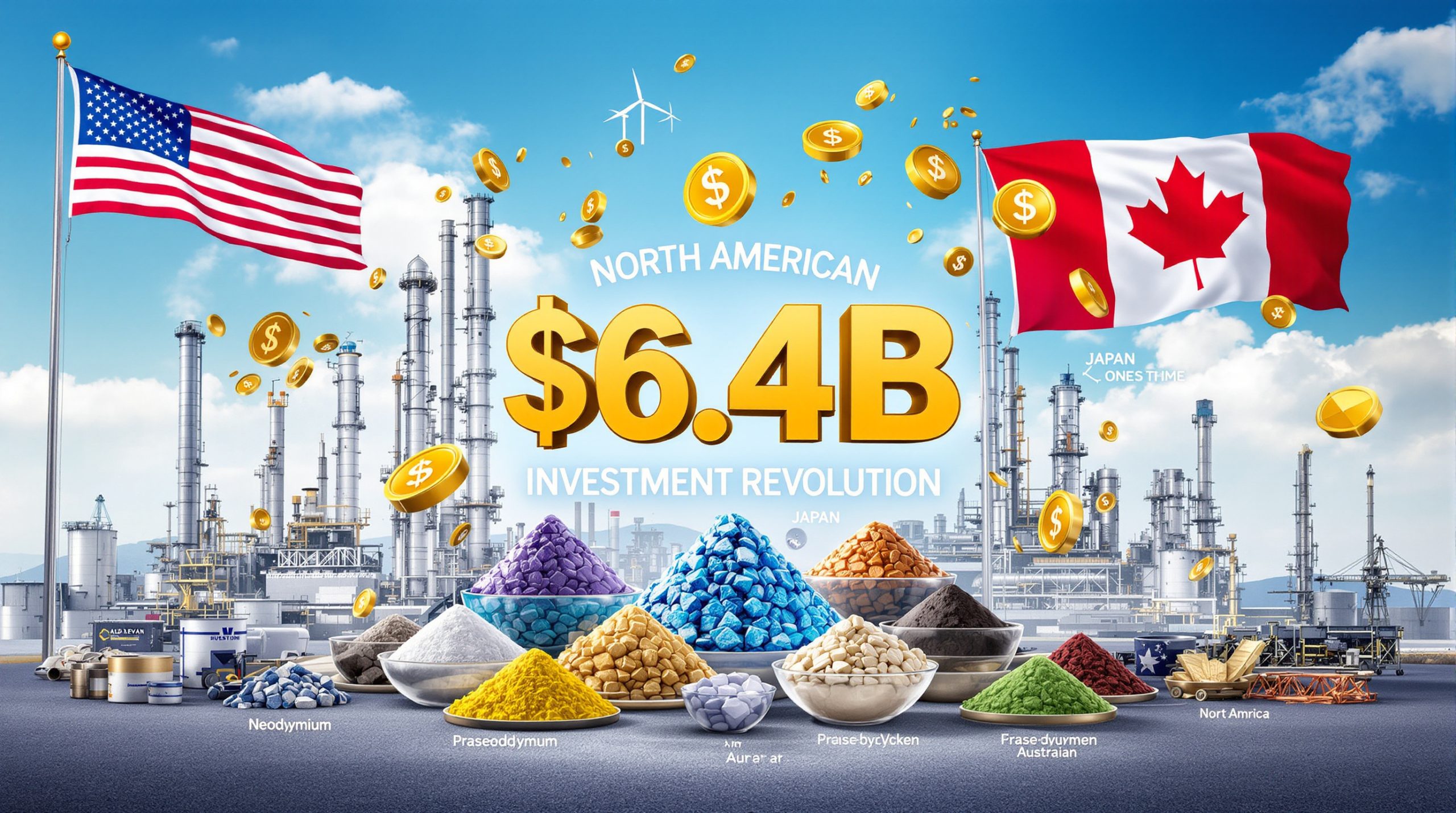The global landscape of critical mineral supply chains experienced a pivotal transformation when seven industrialised nations formalised their strategic commitment to reducing dependence on concentrated processing infrastructure. The G7 critical minerals alliance represents far more than diplomatic cooperation, signalling a fundamental restructuring of how Western economies approach resource security in an increasingly complex geopolitical environment.
This comprehensive framework emerged from growing recognition that current supply chain vulnerabilities pose significant risks to clean energy transitions, defence manufacturing, and advanced technology sectors. Furthermore, the alliance structure creates mechanisms for coordinated investment, technology sharing, and strategic planning across multiple nations and industrial sectors.
How Chinese Processing Dominance Shapes Global Supply Chain Strategies
The Scale of Concentrated Processing Infrastructure
Current market dynamics reveal unprecedented concentration of critical mineral processing capabilities within a single nation's industrial base. Chinese facilities handle approximately 85% of global rare earth oxide refinement operations, while simultaneously controlling roughly 90% of neodymium-iron-boron magnet manufacturing worldwide.
| Processing Stage | Market Share | Strategic Implications |
|---|---|---|
| Rare Earth Oxide Refining | 85% | Controls value-added processing |
| NdFeB Magnet Production | 90% | Dominates end-product manufacturing |
| Graphite Processing | 70% | Critical for battery supply chains |
| Lithium Refining | 60% | Growing influence in EV sector |
This concentration extends beyond simple market share statistics. The integrated nature of Chinese processing infrastructure creates substantial barriers for alternative suppliers seeking to enter global markets. Decades of state-directed investment, coordinated industrial policy, and aggressive pricing strategies eliminated many Western competitors during the 1990s and 2000s.
Export Control Mechanisms and Economic Leverage
Beijing's strategic deployment of export restrictions demonstrates how processing control translates into geopolitical influence. Recent regulatory adjustments targeting specialised materials like terbium, dysprosium, and finished magnetic components showcase the vulnerability of Western supply chains dependent on Chinese midstream capabilities.
The effectiveness of these controls stems from the technical complexity of separation processes. Unlike raw ore extraction, rare earth oxide separation requires sophisticated chemical processing facilities that take years to develop and optimise. Consequently, this creates persistent bottlenecks that cannot be quickly resolved through increased mining activity alone.
Core Components of the G7 Critical Minerals Alliance Framework
Financial Architecture and Investment Distribution
The alliance operates through a sophisticated multi-tiered funding structure designed to accelerate project development across the entire value chain. Initial commitments total C$6.4 billion (US$4.57 billion), strategically distributed across mining operations, processing facilities, and research initiatives spanning multiple countries.
Investment Priority Categories:
- Upstream Development: Mine construction and capacity expansion projects
- Midstream Processing: Separation facility establishment and technology transfer
- Downstream Manufacturing: Magnet production and component assembly capabilities
- Research & Development: Technology advancement and recycling innovation programs
The funding structure recognises that successful supply chain diversification requires coordinated investment across all processing stages. Historical attempts to address supply vulnerabilities through mining investments alone have proven insufficient without corresponding midstream capacity development.
International Partnership Architecture
The collaborative framework extends significantly beyond G7 core members to include strategic partnerships with resource-rich nations and technology leaders. This approach aims to create resilient supply networks spanning multiple continents and political systems whilst maintaining technological compatibility and quality standards.
Partnership agreements encompass technology transfer, joint research initiatives, and coordinated investment programs. In addition, the framework includes provisions for intellectual property sharing, standardised quality specifications, and harmonised regulatory approaches across participating nations.
Leading Projects in Western Supply Chain Development
Major Canadian Processing Initiatives
Nouveau Monde Graphite Operations
The Matawinie facility in Montreal, Quebec represents one of the most significant Western investments in natural graphite processing infrastructure. With over $35 million from the Canada Growth Fund plus substantial international backing, this project positions North America's largest integrated natural graphite facility for battery supply chain applications.
International partnerships include Panasonic (Japan), Traxys (Luxembourg), and direct Japanese government investment commitments. The facility's strategic significance extends beyond capacity additions to include technology demonstration and workforce development programs that could be replicated across allied nations.
Rio Tinto Scandium Expansion
Located in Sorel-Tracy, Quebec, this project represents a critical advancement in allied scandium supply security. The approximately $25 million equity-like royalty from the Canada Growth Fund supports expansion from demonstration scale to commercial production levels.
Scandium applications in aerospace and defence sectors make this project particularly strategic for alliance security objectives. Furthermore, the facility development includes technology optimisation for processing various feedstock compositions and establishing quality standards for high-performance applications.
Rare Earth Processing Breakthrough Initiatives
Ucore Rare Metals Kingston Facility
The Kingston, Ontario facility represents the first commercial-scale rare earth refinery development in North America in decades. With up to $36.3 million from Canadian federal sources, this project focuses on advanced separation technology for samarium and gadolinium production.
The facility utilises RapidSX™ processing technology, representing a significant advancement over conventional separation methods. International collaboration includes partnerships with Vacuumshmelze (Germany) and Permag (USA), along with feedstock agreements spanning Australia and North America.
This project addresses the critical midstream bottleneck that has prevented Western supply chain independence. Even established operations like Mountain Pass continue shipping concentrate to Chinese facilities for final processing, highlighting the persistent technological and capacity gaps in non-Chinese supply chains.
Processing Timeline Challenges for Western Independence Goals
Infrastructure Development Realities
Establishing new separation facilities requires significantly longer timeframes than political announcements typically acknowledge. Industry analysis indicates that developing new rare earth processing capabilities spans 5-7 years from initial investment to commercial production, assuming favourable regulatory environments and stable funding.
"Critical infrastructure development cannot be accelerated through financial commitments alone. Technical optimisation, workforce training, and supply chain integration require sustained effort across multiple development phases."
The complexity extends beyond facility construction to include process optimisation for varying feedstock compositions, regulatory compliance across multiple jurisdictions, and integration with both upstream suppliers and downstream manufacturers.
Converting Capital Commitments to Operational Capacity
Financial pledges represent the initial phase of complex development processes requiring sustained execution across multiple years. Converting investment commitments into operational processing capacity involves several critical phases:
Regulatory and Environmental Compliance:
- Environmental impact assessments and permitting processes
- Health and safety regulatory approvals
- International trade and export compliance requirements
Technology Development and Transfer:
- Securing proven separation methodologies and licensing agreements
- Adapting processes for specific feedstock compositions
- Establishing quality control and testing capabilities
Workforce and Supply Chain Development:
- Training specialised technical personnel across multiple disciplines
- Establishing reliable feedstock supply relationships
- Developing offtake agreements and customer relationships
Strategic Role of Offtake Agreements in Supply Chain Security
Government-Backed Purchase Commitments
Strategic offtake agreements between G7 governments and mining companies create demand certainty essential for project financing. These arrangements guarantee long-term purchase commitments at predetermined pricing structures, reducing investment risks that have historically deterred private capital from critical mineral projects.
Examples of Strategic Offtake Frameworks:
- Canadian government agreements securing natural graphite supply from Nouveau Monde operations
- Rio Tinto scandium production supported through government purchase commitments
- Vianode synthetic graphite facility backed by General Motors offtake agreements
These commitments create stable revenue projections that enable debt financing and accelerate development timelines. Government backing also provides credibility for additional private sector partnerships and international collaboration agreements.
Risk Mitigation Through Diversified Sourcing
The G7 critical minerals alliance strategy emphasises geographic and technological diversification to reduce single-point-of-failure vulnerabilities. This approach involves developing processing capabilities across different jurisdictions whilst maintaining technological redundancy and supply chain flexibility.
Diversification extends to feedstock sources, processing technologies, and end-market applications. Consequently, this comprehensive approach reduces systemic risks that could disrupt supply chains through natural disasters, political instability, or technical failures at individual facilities.
Technology Partnerships Strengthening Alliance Capabilities
Cross-Border Innovation Collaboration
International technology sharing agreements enable rapid capability transfer between allied nations, accelerating development timelines and reducing technical risks. German processing expertise combines with Canadian mineral resources, while Japanese battery technology integrates with North American graphite production capabilities.
Priority Technology Transfer Areas:
- Advanced Separation Chemistry: Next-generation rare earth oxide purification methods
- Magnetic Materials Manufacturing: High-performance permanent magnet production techniques
- Recycling and Recovery Technologies: End-of-life component processing and material recovery
- Quality Standardisation: Harmonised specifications across allied supply chains
These collaborations leverage existing expertise whilst building new capabilities across alliance members. However, the success of mining industry innovation in this context reduces development costs and risks while accelerating the timeline for achieving operational independence.
Coordinated Research and Development Programs
Alliance R&D efforts focus on breakthrough technologies that could fundamentally alter global supply chain dynamics. Priority research areas include direct extraction methods that bypass traditional processing bottlenecks, alternative material development, and advanced recycling processes that reduce primary material requirements.
Joint research initiatives pool resources and expertise whilst avoiding duplication of effort across alliance members. For instance, coordinated programs also ensure compatibility between technologies developed in different countries, facilitating future integration and scaling efforts.
Economic Implications for Global Mineral Markets
Price Discovery and Market Structure Evolution
Increased Western processing capacity could significantly influence global pricing structures, particularly for materials where Chinese producers currently maintain price-setting authority. However, the scale and timing of new capacity additions will determine the magnitude and timeline of market impacts.
Current Chinese cost advantages stem from economies of scale, integrated supply chains, and decades of process optimisation. New Western facilities must achieve competitive cost structures whilst meeting higher environmental and labour standards, creating complex trade-offs between security and economic objectives.
The energy transition and critical minerals relationship becomes particularly relevant as these market dynamics evolve across different sectors.
Investment Flow Redirection and Capital Allocation
The G7 critical minerals alliance framework channels both public and private investment toward non-Chinese supply chains, potentially redirecting billions in capital flows over the coming decade. This redirection could accelerate project development timelines whilst creating new centres of processing excellence across allied nations.
Private sector response to government commitments will determine ultimate success. Public funding serves as catalyst and risk mitigation, but achieving industrial-scale capacity requires substantial private capital participation and long-term commercial viability.
What Are the Effectiveness Measures for Reducing Chinese Processing Dependence?
Short-Term Constraints Versus Long-Term Strategic Goals
Current market analysis indicates that Chinese processing dominance will persist for the immediate future, regardless of Western investment commitments. The G7 critical minerals alliance represents long-term strategic repositioning rather than near-term solutions to supply vulnerabilities.
Realistic Timeline Expectations:
- 2025-2027: Continued heavy reliance on Chinese processing infrastructure
- 2028-2030: Initial Western processing capacity achieving commercial production
- 2031-2035: Meaningful diversification of global processing capabilities
- Post-2035: Potential for balanced global processing distribution
The timeline reflects technical realities of facility development, workforce training, and market development rather than political objectives or funding availability. Accelerating these timelines requires sustained commitment across multiple electoral cycles and changing political priorities.
Measuring Alliance Success Through Capacity Metrics
Alliance effectiveness must be measured through specific capacity milestones rather than investment announcements or political statements. Key performance indicators include quantifiable improvements in Western processing capabilities and supply chain diversification.
Critical Success Metrics:
- Annual Processing Capacity: Tonnes of separation capability outside Chinese facilities
- Geographic Distribution: Number of operational facilities across alliance nations
- Supply Chain Integration: Percentage of Western demand met through allied sources
- Technology Development: Breakthrough innovations in extraction and processing efficiency
These metrics provide objective assessment of progress toward supply chain diversification goals whilst avoiding the political rhetoric that often accompanies international cooperation initiatives.
Challenges That Could Undermine Alliance Objectives
Political Continuity and Long-Term Policy Consistency
Long-term infrastructure projects require sustained political support spanning multiple election cycles and changing government priorities. Critical mineral processing facilities represent 15-20 year investment horizons that extend well beyond typical political planning cycles.
Changes in government priorities, trade policies, or international relations could disrupt project development and funding commitments. The alliance framework requires institutional mechanisms to maintain continuity despite political transitions in member countries.
Examining European CRM facility developments provides insight into how regional approaches handle these continuity challenges across different political systems.
Economic Competitiveness and Cost Structure Challenges
Chinese processing facilities benefit from decades of optimisation, massive scale economies, and integrated supply chain networks. New Western facilities must achieve cost competitiveness whilst meeting substantially higher environmental, labour, and safety standards.
This creates fundamental economic challenges that cannot be resolved through subsidies alone. Long-term viability requires genuine cost competitiveness or sustained government support that may not survive changing political priorities or fiscal constraints.
Technical and Operational Implementation Hurdles
Establishing new processing capabilities involves significant technical risks that extend beyond financial commitments. Critical implementation challenges include:
Feedstock Variability and Process Adaptation:
- Adapting separation processes to different ore compositions and mineral grades
- Optimising recovery rates and product quality across varying input materials
- Managing impurity levels and contamination issues in processing streams
Environmental Compliance and Regulatory Navigation:
- Meeting stringent Western environmental standards for chemical processing
- Managing radioactive materials and waste disposal requirements
- Obtaining permits across multiple regulatory jurisdictions
Workforce Development and Technical Expertise:
- Training skilled technical personnel in specialised separation technologies
- Developing institutional knowledge and operational expertise
- Maintaining competitive compensation structures for specialised roles
Market Psychology and Investment Strategy Implications
Understanding Supply Chain Vulnerability Premiums
The G7 critical minerals alliance creates both opportunities and risks for investors seeking exposure to supply chain diversification trends. Companies positioned to benefit from Western processing development may command valuation premiums based on strategic value rather than traditional financial metrics.
However, investor psychology often overestimates short-term progress whilst underestimating long-term execution challenges. The gap between political announcements and operational capacity creates potential volatility in critical mineral sector investments.
Geological Factors and Resource Quality Considerations
Western rare earth deposits often present different geological challenges compared to established Chinese operations. Mineral grade variations, processing complexity, and environmental considerations significantly impact project economics and development timelines.
For example, many Western deposits contain higher concentrations of radioactive elements, requiring specialised handling and disposal infrastructure. These factors influence both capital requirements and operating costs, affecting long-term project viability and investment returns.
Understanding mineral beneficiation opportunities in various jurisdictions provides additional context for evaluating processing development potential across different geological settings.
Strategic Outlook for Critical Mineral Independence
The G7 critical minerals alliance represents an ambitious attempt to restructure global supply chains developed over multiple decades. Whilst financial commitments and international cooperation demonstrate serious intent, the timeline for meaningful independence from Chinese processing capabilities extends well beyond current political planning horizons.
Success depends on sustained commitment to long-term infrastructure development, continued international cooperation despite changing political landscapes, and achieving economic competitiveness with established operations. The alliance framework provides essential foundation for transformation, but converting strategic intent into operational capacity remains the defining challenge.
For investors and industry participants, the alliance signals fundamental shifts in government approach to resource security. This creates opportunities for companies positioned to benefit from supply chain diversification whilst highlighting persistent risks associated with concentrated processing capabilities and long development timelines.
The coming decade will determine whether coordinated Western response can effectively challenge established processing dominance or create parallel supply chains serving specific regional markets. Either outcome represents significant departure from current global mineral processing landscapes, with substantial implications for clean energy transitions, defence manufacturing, and advanced technology development.
Furthermore, G7 partnerships with resource-rich nations continue expanding the alliance framework beyond traditional member countries, creating more comprehensive supply chain alternatives.
Investment Considerations:
Investors should recognise that critical mineral supply chain transformation involves multi-year development cycles, substantial capital requirements, and complex technical challenges that cannot be resolved through funding commitments alone. Success requires sustained execution across political, technical, and commercial dimensions over extended timeframes.
The alliance framework creates policy support and funding mechanisms that reduce certain investment risks whilst introducing new dependencies on government priorities and international cooperation. This dynamic requires careful assessment of both strategic opportunities and execution challenges in evaluating critical mineral sector investments.
Want to Stay Ahead of Critical Mineral Investment Opportunities?
With the G7 critical minerals alliance reshaping global supply chains, significant discoveries in lithium, rare earths, and other critical materials could create immediate market advantages. Discovery Alert's proprietary Discovery IQ model identifies these high-potential ASX mineral discoveries instantly, helping investors position themselves before major announcements drive market movements. Begin your 30-day free trial today and discover why historic mineral discoveries have generated substantial returns by exploring our dedicated discoveries page.




